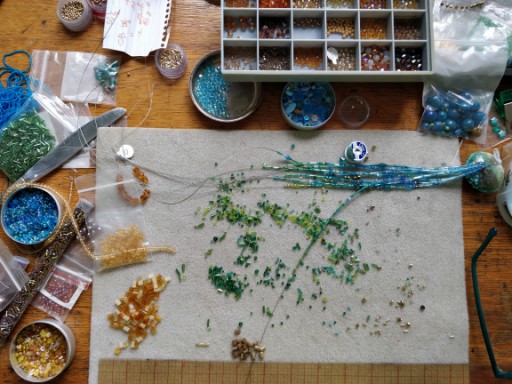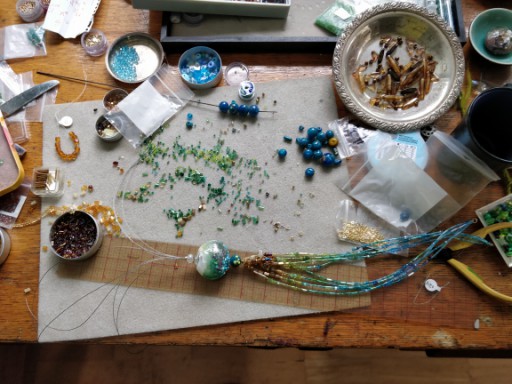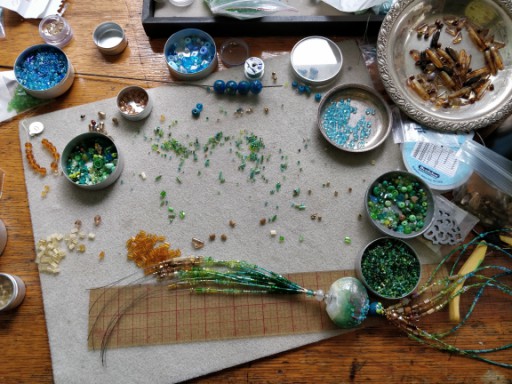I made extensive written and photographic notes for this piece, so it's well documented (mebbe too well...) Enjoy.
I actually cut the beadalon & pulled the clasp a while back (according to my notes, 20Jan2020), but got no further than putting on 2x2 gf crimps, which were pretty tight. Looked at the similar parrot necklace that is a model —for using up beads, the basic tassel design, even for the colour scheme, that good god, I made six years ago...
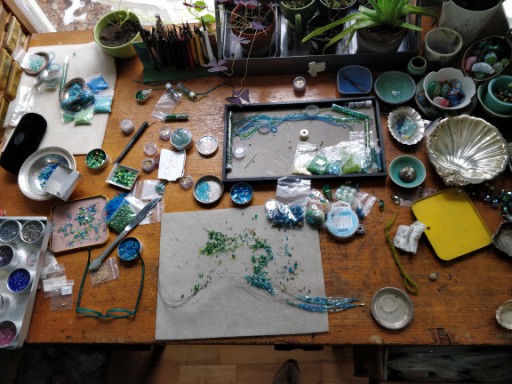
Starting the necklace. I had lots of stuff lying around, making for a rich assortment to choose from. 29jan2020
After looking more closely, I realized one way I made my life easier was by using large, 8/0 seed beads instead of the crimps, so I pulled those puppies off & substituted the glass, which meant I didn't have to use quite as tiny (&, more importantly, beads that were already on the table, the point of this exercise) to get it going. For the first half hour I went like gangbusters.
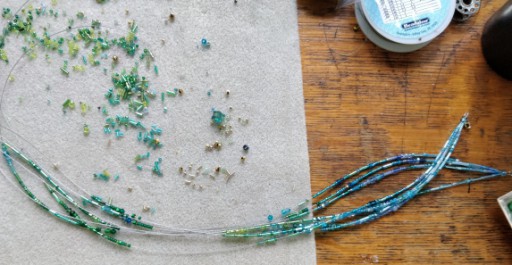
The kelly green transition shown here didn't work, and had be to be removed. Otherwise, the stringing went very efficiently.
Took a break for breakfast, then back to it, and realized that if I tried to squeeze the dark kelly green beads inbetween the aqua and the lime/peridot green, I was gonna have a blip of darker beads in the middle, which I decided was not the look I wanted, so off all those came—I figured I could put them into the tassel, instead.
Really, things went fairly efficiently, even with the stop to pull out a whole bunch of amber/brown/gold beads for the bit right above the focal: yes, the level of chaos sharply increased, but all those beads will be easy to put away, as opposed to the blue-green mess of seed beads I started with.
Until I got to the focal. It has relatively large holes, having been made on a 3/32” mandrel, but the beadalon ends had a slight curviness to them, and they kept hanging up in the ridges on the bottom of the bead. In many many ways, hollow beads are superior to solid ones, but they do have the very real disadvantage of ‘trapping’ stringing material, which has a tendancy of winding itself along inside surface of the bead instead of poking out the hole.
The easiest way to deal with this problem is to line up the holes visually, (by holding the bead at right angles to your pupil) sight along that axis, and rotate the beadalon till goes through. —That gets hard to do with 8 strands, however. If the bead is transparent, you can also see what's going on and rotate the bead and/or beadalon appropriately till it comes out. This bead, however, is mostly opaque. I tried taping the ends into one, pointed strand, but that was too thick to fit.
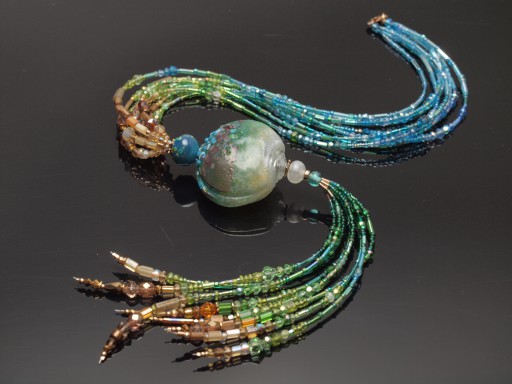
Completed 16mar20. Assorted seed and bugle beads, swarovski and chinese crystal, czech glass, lampwork focal & ‘collar’ beads, gold-filled 2mm, liquid gf, & 14/20 clasp. The heishi and bali (style) “granulated” star are plated, (as are the ending crimps.) zuiko macro lens, E620, f8 (i think) lumopro flash. This image has been edited to combine two exposures.
Finally I took a diamond bit and ground the lower hole so that it was conical, that is, more of a funnel shape. This brought the exercise down to a level of frustration I was willing to tolerate...the beadalon fit through the ancient blue-green designer (a sample from the commemorative bead project[1] ) but then I wanted something for underneath...I was afraid I'd have to actually make a bead, but I found a little white pixie that I aggressively ground the holes to fit. Then it was just a matter of squashing a 4mm gf, drilling its hole bigger, getting the bead stuck to the diamond bit, popping it off with pliers, having fly away and land underneath the plant table, finding that, putting it on—aaaaand it's tight enough to hold by friction. Perfect. So that was roughly 10:30–1:30, and then I broke for lunch.
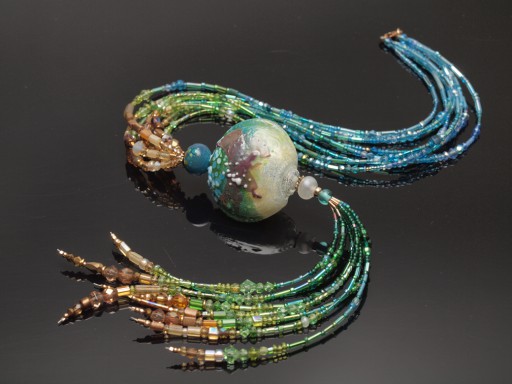
Overall length from clasp to tip of tassel: about 18.75"; opening, about 21"; focal is about 1.5" x 1.75" x 3/4"; tassel (measured from bottom of focal: 6". This view shows what I consider to be the obverse side of focal, which is made with Thompson enamel, frit, CiM plum shards. Photographed 16mar2020, f8, 1/125sec, lumopro flash, full power.
Started tassel around 4pm, worked on it for an hour, went to f2tE's, then did ...uhhhhn the last inch or so on the remaining two strands. Also did two mouse tails to finish off the last of the seed beads. Tidied up somewhat. Ends still need to be crimped with final dangle, but I'm exhausted and going to bed, will do that tomorrow when fresh.
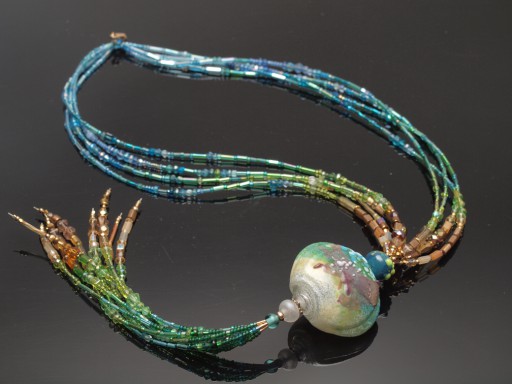
A more conventional styling: the others are somewhat unusual in that they disguise, a bit, how the piece is worn, but I much prefer them.
UPDATE, 16mar2020. So then things sat for roughly two months, until I did this aggravating new thing to register my resale tax license with my out-of-state vendors & ordered some teeny tiny crimps in gold-colour so I could finally complete this piece. Owing to the small size of the beads in the necklace, and the fact that the focal is hollow, it's very lightweight—about 60g, or just over 2 oz.
[1]So that means the bead is only 18 years old...
Unless otherwise noted, text, image and objects depicted therein copyright 1996--present sylvus tarn.
Sylvus Tarn